- Blog
- Agentic Experience
- Generative AI
- 8 min read
Single Agent vs Multi-Agent AI: Which One to Choose in 2026?
Published
13 May 2025Updated
5 December 2025
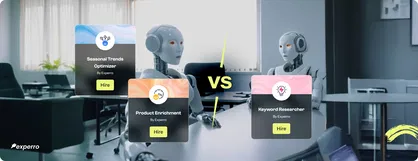
Key Takeaways
- Single-agent systems offer simplicity, speed, and lower resource needs—ideal for focused, isolated tasks.
- Multi-agent systems enable collaboration, scalability, and adaptability in complex, dynamic environments.
- The choice between single agent vs multi-agent in AI framework depends on task complexity, scalability needs, and system resilience.
- Experro enables seamless agentic commerce with AI-powered search, personalization, and dynamic merchandising, enhancing your eCommerce performance.
Multi-agent systems vs single agents: What’s right for your AI (Artificial Intelligence) strategy?
They’re no longer just futuristic concepts—AI agents are now central to how modern eCommerce platforms operate.
But every intelligent action is driven by an architectural decision: should you rely on a single AI agent or deploy a system of multiple interacting AI agents working in sync?
This choice shapes how your business handles decision-making, agentic personalization, scalability, and even customer experience.
In this blog, we’ll unpack the core differences between single agent vs multi-agent AI. Plus, we’ll look at how the best agentic experience platforms like Experro enable intelligent, goal-driven AI behaviors, without the complexity of managing multiple agents.
Now, let’s explore the AI agent systems comparison guide in the next section.
Single Agent vs Multi-Agent – The Differences You Need to Know
When comparing single vs multi AI agents, it’s not about which is better—it's about the tasks requiring diverse expertise and what fits your goals.
While single-agent systems offer simplicity and speed, multi-agent systems bring coordination and scale.
Below is a table summarizing the differences between multi-agent and single agent systems:
Feature | Single Agent System | Multi-Agent System |
|---|---|---|
| Meaning | Simple and individual task handling | Collective decision-making by multiple agents |
| Architecture | Centralized | Distributed |
| Decision-making | Independent | Collaborative or competitive |
| Scalability | Limited | Highly scalable |
| Fault Tolerance | Low (single point of failure) | High (redundancy through multiple AI agents) |
| Flexibility | Static | Dynamic and adaptive |
| Use Case Example | Basic product recommendation | Collaborative filtering with live feedback |
| Complexity | Low | High |
| Efficiency in Complex Scenarios | Limited | High |
Overall, the ready-to-deploy AI agents are favored by enterprises, accounting for 69% of the market, as they reduce development time and costs.
Here’s multi-agent vs single agent AI explanation. Let’s dive in.
What Is a Single Agent System?
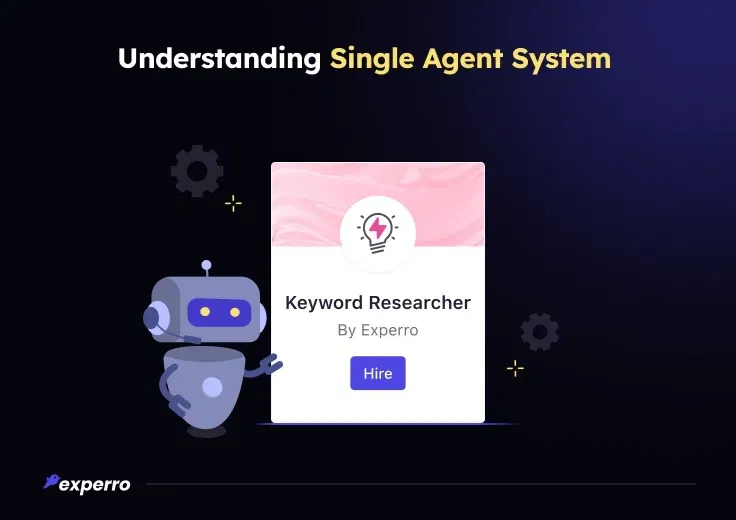
A single-agent system refers to an AI setup where one autonomous entity operates independently to complete the tasks.
It observes its environment, makes decisions, and takes actions without coordinating with other intelligent agents. Think of a recommendation engine working in isolation or a chatbot answering basic queries without context sharing.
These systems are easier to build and manage. They’re best suited for single vs multi-agent workflows that are linear or well-defined, such as basic search or navigation tasks.
In many cases, single agent AI vs multi-agent AI in eCommerce favors the former when the task scope is limited.
Before we decide on the right AI agent architecture, let’s look at the single agent vs multi-agent pros and cons, starting with single agents.
What Are the Pros & Cons of Single Agents?
Single-agent systems are often the go-to solution for straightforward tasks, but they come with their own set of strengths and limitations.
Let’s take a closer look at the pros and cons.
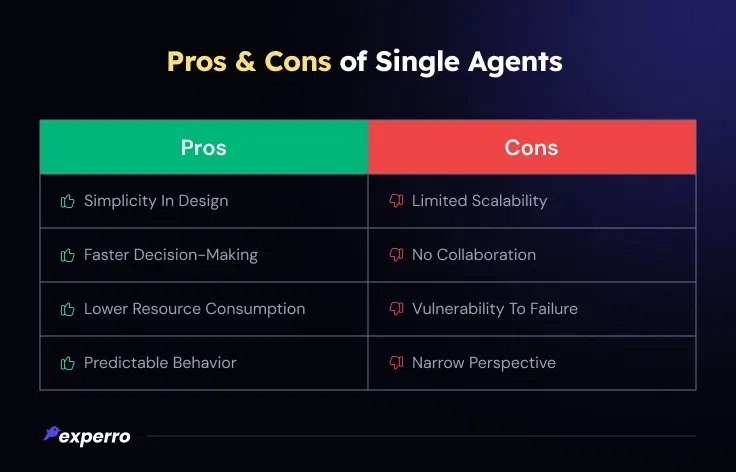
✅ Pros of Single Agents
Single-agent systems offer several advantages, particularly for simpler tasks or smaller-scale operations.
Let’s explore some of the key benefits.
1. Simplicity in Design
A single-agent system is easy to design and deploy. There’s no need to handle inter-agent communication, negotiation, or synchronization. This simplicity translates into faster development and easier debugging.
2. Faster Decision-Making
With no dependencies on other agents, decisions are made instantly. This makes single agent vs multi-agent systems ideal for real-time responses in low-stake environments.
3. Lower Resource Consumption
Single agents typically require less computational power and memory. This makes them cost-effective for startups or simpler use cases in the retail AI agent systems comparison
4. Predictable Behavior
These agents offer predictive customer analytics that support stable, repeatable results that are essential for long-term strategy and resource allocation.
❌ Cons of Single Agents
While single-agent systems have their strengths, they come with limitations that can hinder performance as demand grows.
Let’s look at some key drawbacks.
1. Limited Scalability
As task complexity grows, a single agent may struggle with handling large data volumes, managing multiple goals, or adapting to dynamic environments. In single vs multi-agent AI systems, single agents are not suited for large-scale coordination or multi-channel decision-making.
2. No Collaboration
A single agent can’t share insights or delegate tasks. This isolation makes it ineffective in systems that require collaboration or simultaneous operations.
3. Vulnerability to Failure
One key drawback in the multi-agent systems vs single agents discussion is reliability of single agents. These don't offer fallbacks (backups), making them more vulnerable to total system failure.
4. Narrow Perspective
A single agent can only process what it sees. It lacks the holistic viewpoint available in multi-agent systems vs single agent systems, where agents can share environmental context.
Now that we have learnt about the pros and cons of single agents, let’s dive deeper into the multi-agent system.
What Is a Multi-Agent System?
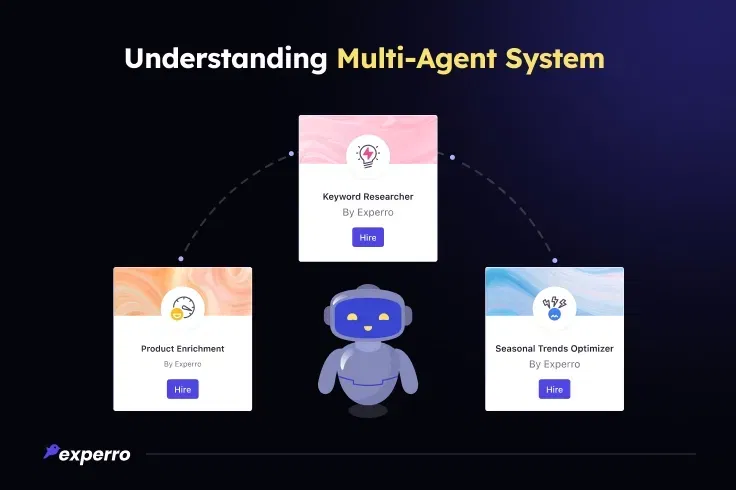
A multi-agent system (MAS) is a collection of multiple intelligent agents that interact within an environment to solve complex problems collaboratively.
Multi-agent collaboration may work cooperatively or competitively, often sharing data and responsibilities in real time.
This setup excels in distributed decision-making, adaptability, and handling dynamic environments. AI agents and multi-agent systems are increasingly used in eCommerce for dynamic pricing, profile-based personalized suggestions, and inventory balancing.
They form the core of scalable single agent and multi-agent AI architectures that evolve with growing business needs.
Comparing single vs multi AI agents?
Let Experro guide you to the right agentic AI solutions for your business!
What Are the Pros & Cons of Multi Agents?
Let’s flip the coin and explore multi-agent vs single agent setups from the other side.
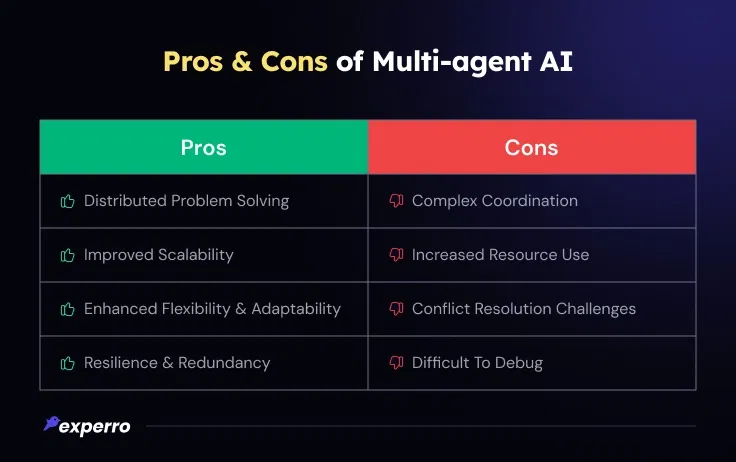
✅ Pros of Multi-Agent Systems
Multi-agent systems offer several advantages, especially in complex, dynamic environments that benefit from collaboration and scalability.
Let’s explore some of the key advantages of multi-agents below.
1. Distributed Problem Solving
Multiple agents working in parallel can break down complex problem-solving tasks into smaller, manageable parts. With effective AI agent orchestration, this collaborative workforce enables efficient and scalable workflows.
2. Improved Scalability
As your system grows, you can add more agents without redesigning everything. This makes multi agent in AI more future-proof for eCommerce and enterprise use.
3. Enhanced Flexibility and Adaptability
Agents can dynamically re-assign roles and adapt to new conditions. In single or multi-agent systems, this gives AI workforce systems the upper hand in volatile markets.
4. Resilience and Redundancy
If one agent fails, others continue. This design mirrors real-world eCommerce needs where uninterrupted service is critical.
❌ Cons of Multi-Agent Systems
While multi-agent systems offer flexibility and scalability, they also introduce several challenges that can impact performance and development.
Here are the disadvantages of multi-agent AIs:
1. Complex Coordination
Communication among agents can get messy. Synchronizing actions, resolving conflicts, and managing message queues require complex programming.
2. Increased Resource Use
More agents lead to increased computational load and data exchange. This can increase costs, especially in single agent vs multi-agent systems in retail environments.
3. Conflict Resolution Challenges
Specialized expertise of AI agents might have overlapping goals or contradicting actions. Managing this conflict is harder than managing a single agent and multi-agent system.
4. Difficult to Debug
Issues can stem from hidden inter-agent dependencies, making it hard to trace root causes. Debugging one agent often misses broader systemic faults, as problems may lie in the way agents interact rather than in the agents themselves.
Without full visibility into the ecosystem, even small misalignments can cascade into (lead to) larger failures.
Now that we’ve covered the pros and cons of both approaches, let’s explore the multi-agent vs single agent dilemma to see which one is better suited to lead the future of AI.
Multi-Agent vs. Single-Agent AI: Which Will Lead the Future?
The future isn’t about choosing sides—it’s about context. Single agent AI vs multi-agent AI efficiency depends on your business needs.
Single agents may lead in predictable, isolated tasks, while multi-agent systems will thrive in complex system, collaborative environments like gen AI-powered personalization or warehouse automation.
Ultimately, businesses must focus on deciding between single agent and multi-agent architectures based on use case complexity, budget, and long-term scalability.
The latest Agentic AI statistics are in! Take a dip into AI Agent statistics that matter!
What Can Experro’s Agentic Commerce Do for Your Business?
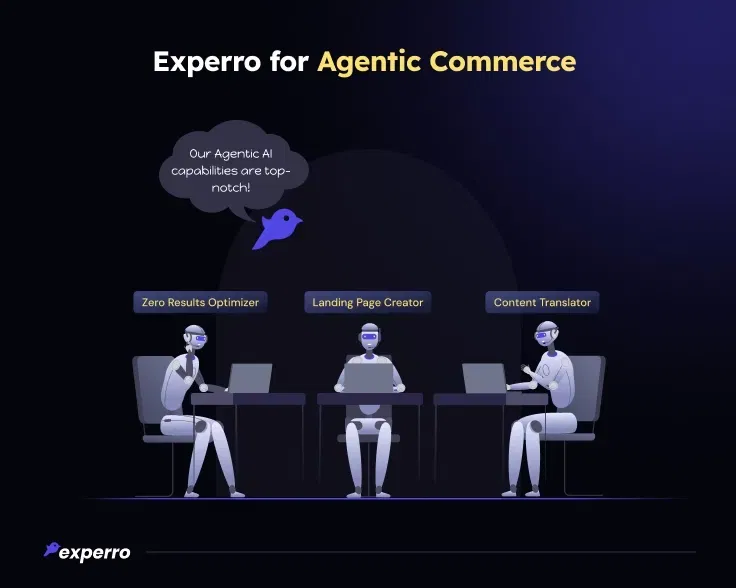
Experro brings agentic commerce to life by powering intelligent, goal-driven actions across your digital storefront.
From Gen AI-powered search and personalization to merchant intelligence dashboard, our platform lets autonomous agents operate with real-time context, driving better engagement and faster conversions.
Without adding complexity, Experro helps you embrace the benefits of agentic experiences like adaptability, efficiency, and smarter decision-making.
Built-in intelligence guides you through the evolving landscape of AI agent systems, helping you choose what works best for your business.
Elevate your store with Experro’s advanced agentic capabilities!
To Conclude
When it comes to AI architecture, there’s no one-size-fits-all. Choosing between single and multi-agent AI depends on the complexity and nature of the task at hand. While single agents offer simplicity, multi-agent systems open doors to collaboration, scale, and resilience.
As AI evolves, having the right foundation matters. Whether you choose single or multi-agent AI, make sure it aligns with your business goals and user experience.
Schedule a call with our experts for personalized guidance on the best AI setup for your commerce business.
FAQs
Is single-agent AI cost-effective for eCommerce?
Yes, single-agent AI systems are generally more affordable and faster to implement for straightforward use cases like product search or recommendations.
Which is better: single or multi-agent AI?
Deciding on multi-agent or single agent systems depends on your business needs.
- Single-agent systems are ideal for well-defined, specialized tasks with clear objectives—like personalized product recommendations or autonomous search. They’re easier to implement, require fewer resources, work with large language models and offer faster decision-making.
- On the other hand, multi-agent systems shine in complex, dynamic environments where multiple agents must collaborate, adapt, and coordinate actions—such as supply chain optimization or multi-modal customer support and other advanced capabilities.
Instead of choosing, which is better universally, the right choice hinges on the nature of the task, infrastructure readiness, and long-term goals.
Tip! - Often, businesses benefit from a complex system that utilizes multi-agent approach tailored to specific functions.
When to use single agent AI vs multi-agent AI?
When comparing single vs multi-agent AI, consider these key decision factors:
- Task Complexity – Simple tasks favor single and individual agents; complex, evolving tasks suit multi-agent setups.
- Collaboration Needs – Multi-agent systems are better for distributed, cooperative operations.
- System Scalability – Multi-agent systems scale well with growing tasks and nodes.
- Fault Tolerance – Multi-agent systems provide redundancy; single-agent systems have single points of failure.
- Implementation Time – Single-agent systems are quicker and easier to deploy.
- Budget Constraints – Multi-agent systems often require more resources and development effort.
- Data Analysis & Control – Consider how much control you need over decisions and data exchange.
What is an example of a single agent environment?
A web search engine responding to a single user’s query without collaborative input is a good example of a single agent vs multi-agent environment.
Is Experro suitable for businesses exploring agentic AI strategies?
Absolutely. Experro supports goal-oriented AI behaviors, like real-time recommendations, intelligent search, and dynamic merchandising, built directly into the platform.
It delivers the benefits of agentic AI without the complexity of managing multi-agent architectures, making it ideal for businesses seeking intelligent automation with simplicity.
How AI agents differ in single vs multi setup?
In a single agent setup, one AI agent operates independently to complete a specific task—it's optimized for focus, speed, and simplicity. There's no need for coordination or communication with other agents.
In a multi-agent setup, multiple AI agents work together (or sometimes compete), each with distinct roles or goals. These agents can share information, negotiate, and collaborate to solve complex, dynamic problems that one agent alone couldn’t handle.
The key difference lies in autonomy and interaction, multi-agent systems require coordination, while single-agent systems do not.
Pallavi Dadhich
Content Writer @ ExperroPallavi is an ambitious author recognized for her expertise in crafting compelling content across various domains. Beyond her professional pursuits, Pallavi is deeply passionate about continuous learning, often immersing herself in the latest industry trends. When not weaving words, she dedicates her time to mastering graphic design.
What's Inside
- Single Agent vs Multi-Agent – The Differences You Need to Know
- What Is a Single Agent System?
- What Are the Pros & Cons of Single Agents?
- What Is a Multi-Agent System?
- What Are the Pros & Cons of Multi Agents?
- Multi-Agent vs. Single-Agent AI: Which Will Lead the Future?
- What Can Experro’s Agentic Commerce Do for Your Business?
- To Conclude
Subscribe to Our Newsletters
Get the latest insights delivered straight to your inbox.